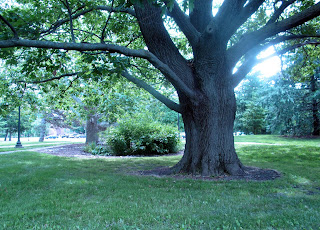Victoria Figueroa is a summer intern with IISG. She is on the University of Illinois campus, working with Eliana Brown, stormwater specialist. She will be engaged in raising awareness about the benefits and beauty of rain gardens.
A Chicagoan born and raised, I was not used to being surrounded by so much green. There are plenty of parks in the city, but you never feel like you are surrounded by nature. But when I moved to Urbana for school, I realized just how much of a city kid I was and how much I could enjoy being surrounded by so much green, in particular trees. One night, walking around campus with a couple friends, we thought we would try our luck at climbing trees. This may not have been the best idea as it was dark and the two big (oak, I later learned) trees were surrounded by rocks and overgrown shrubs. But the light coming from the detention pond not too far away was enough to give us the confidence to try.

Now I didn’t succeed, but what was once just a meaningless patch of land on my campus, became a memory I now have a great fondness for. Just imagine my surprise when I learn that those rocks and shrubs I was playing in were not just there for decoration. Those stones and plants were not just there as placeholders. That night my friends and I had played in a rain garden. Our amusement might not have been the use the gardeners and students who built the garden had in mind, but it was very natural.
But what is a rain garden? A rain garden is built in a bowl shape, which gives rainwater runoff from surfaces that do not absorb water, like roofs, sidewalks, and roads, the opportunity to be absorbed. This helps to control flash floods, remove pollutants, improve water quality, and recharge groundwater. Not only do these gardens provide wildlife habitats, but are also an attractive alternative to detention ponds and can be adapted to fit into the existing urban landscapes. This is why it was so easy to walk through a rain garden on my college campus. It did not feel out of place. It was not intrusive and blended well in between the dorm building and its surroundings.
Rain gardens are a relatively new approach to treating stormwater runoff. Stormwater runoff is any water originating from rainfall or melted ice or snow. Stormwater runoff not only transports pollutants, but is also a creator of pollution itself. A study conducted by the Environmental Protection Agency from 1979-1983 found that stormwater runoff contributed to poor water quality in receiving streams. This can be particularly harmful in urban areas because of the great amount of hard surfaces like roads, walkways, and parking lots that do not allow water to be absorbed. This then causes a larger percentage of stormwater runoff than in more rural areas. Therefore it is important for urban areas to be able to manage the excess water that comes along with living in our concrete jungles. Rain gardens were created to mimic natural water retention areas, which existed before the development of urban environments and they began to be developed for residential use in 1990.
There are many ways of going about treating water in urban areas, and rain gardens are a good way to start. They are unassuming and they can be implemented in your own yard. Not only are rain gardens helpful but they can very beautiful as well. Like any garden, its appearance can vary. It really depends on what the gardener makes of it. Rain gardens could have more plants that resemble grass and be very subtle or many blossoming plants and add more color to their yard.
Maybe one day I’ll have one in my own back yard. But first I invite you to follow me in my future blog posts as I search for the perfect fit for my future garden, whether I keep Chicago as my home or move away and settle down elsewhere.


